| Darnussia–Keymon War | |||||||
|---|---|---|---|---|---|---|---|
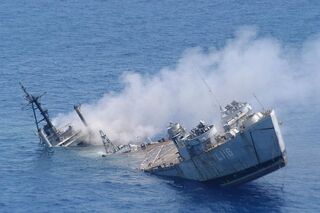 Darnussian battleship DRS Robervou sinks in the Migrant's Pass during the Battle of Jan | |||||||
| |||||||
| Belligerents | |||||||
| Allies |
Keymon-Hutori Alliance | ||||||
| Commanders | |||||||
| Strength | |||||||
| Casualties and losses | |||||||
The Darnussia–Keymon War,[1] also known as the Heinovich War (Darnussia), and the Great Patriotic Defensive War (Keymon) was a war between the Second Darnussian Democratic Republic and the Democratic People's Republic of Keymon that also involved the Holy Luthori Empire, Rutania, and Malivia on the side of Darnussia; and Hutori on the side of Keymon. The conflict started over disputes of Keymon harbouring Lusitânian terrorists by Darnussia, and Keymon's subsequent declaration of war. After a nuclear bomb was dropped on Merenbürg, public opinion turned against Keymon, and Keymon soon found itself invaded and occupied after a brief conflict. Approximately 200,000 people lost their lives in the conflict.
Roots of the conflict[]
Accusations of Lusitanian terrorists[]
The relationship between Darnussia and Keymon had always been one of traditional peace and harmony, with the Darnussians usually giving Keymon support during its international disputes. This all changed however on 17 July 3031, when 2500 top secret documents were leaked from the Keymonite ministry of Internal affairs to the Darnussian government via a Keymonite Stalinist revolutionary. They detailed the harbouring of Lusitânian terrorists by Keymon in return for large amounts of casino and organised crime profits.
This alarmed Darnussia, Keymon and the international community, who knew how sensitive the topic of Lusitanians was to Darnussia even after 800 years. An ultimatum was sent on 19 July to Keymon from Ludwig Hermann Tobias, Darnussian foreign secretary and Commander in Chief of the Darnussian military, asking about more information regarding the terrorists. When this went unanswered a second was sent, now demanding a proper reply within 24 hours or face further action. At midnight on 20 July, a reply was recieved: Darnussia had nothing to do with Keymonite affairs, and would not hand over any persons to the Darnussian government.
Keymonite Coup and Operation Sebastian[]
| Operation Sebastian | |||||||
|---|---|---|---|---|---|---|---|
| |||||||
| Belligerents | |||||||
| Lusitânian Insurgents | |||||||
| Commanders | |||||||
| Unknown | |||||||
| Casualties and losses | |||||||
| Unknown | |||||||
Alarm bells rang around Terra, as international forces pleaded for Darnussia not to go to war with Keymon, and at the same time begging Keymon to remove the Lusitânians from Darnussia. The immeadiate threat of war seemed to dissolve.
However, on 19 August 3031, Communist forces staged a coup in Keymon, and took control. An isolationist, Stalinist government was placed in power, led by the New Labour Party, and the hard-line despot, Versteeg IV. The NLP were in full power by around the 1 November. On the 5, an ultimatum was recieved by the Keymonites from Darnussia, regarding the Lusitânian terrorists. Darnussia recieved a short and blunt reply: "They will be dealt with hard". Further communication was difficult, and Darnussia remained on standby until May 3032, when Darnussian leaders met with the NLP in Keymon City. It was here that the Keymonites assured the Darnussians that the Lusitanians had been either executed, imprisoned or expelled from Keymon, that their worries began to settle.
Keymon went back to being isolationist, and Darnussia began "Operation Sebastian", named after Czár Sebastian I, the Deltarian king who freed Darnussia from Lusitânian rule in 2317. Operation Sebastian was a world-wide search for the "missing" Lusitânian terrorists. From May 3032-May 3035, it was believed that 2000 Darnussians were killed, and 2,000,000,000 DAR was spent searching for them and spying on certain governments. However in June 3035, Darnussian spies in Keymon discovered that not only had the Keymonites lied to Darnussia about the Lusitânians being expelled, but the NLP was grooming them for a take-over of the Darnussian government.
Leaked Darnussian plans[]
An ultimatum sent on 31 May demanding an explanation went unanswered, and straight away, having lost patience with their eccentric Stalinist tormentors, the Darnussian military drew up plans for a full-scale invasion of Maddog to go ahead by mid-October had the two sides not reach an agreement. A month went by, and it was then that Hutori signed a mutual defensive pact with Keymon. Darnussian morale took a knock, as they realised what serious trouble Darnussia could get into with a war with Hutori. On 31 August, another ultimatum was delivered to Keymon, and this time was answered, briefly, by the Keymonite government: "You have no rights to accuse us. There are no terrorists here". Darnussia staleld and contemplated what to do.
Then, disasterously, on 6 October, Keymonite spies revealed to the entire New Labour Party politburo the Darnussian plans for the invasion of Maddog. Furious, Keymon mobilised its troops and sent an ultimatum to Darnussia:
Astoundingly, this extremely provocotive message went unanswered. Instead, Darnussia mobilised its armed forces and called up all reserves and prepared for the worst Keymon prepared for all-out war.
The war (October 3035 - June 3036)[]
Declaration of war[]

Keymonite Army
At 6:30am on 10 October 3035, the Democratic People's Republic of Keymon declared war on the Second Darnussian Democratic Republic. Keymons armed forces consisted of a measly 70,250 men out of a population of 6 million, despite conscription. Darnussia had 1,200,000 regulars, and 3,400,000 reserves in its army, navy and air force. However, despite Keymon being overwhelmingly outnumbered, they held state-of-the-art nuclear and conventional weapon technology, as well as a strong and up-to-date aerial defence system. Keymons air force was, despite being tiny, considered one of the best in Terra, with extremely well trained and dedicated pilots, plus highly modern and powerful aircraft. Whats more, Keymon was highly protected against military invasion. Politically, it was under the control of a hardline Stalinist dictatorship, so political strife was not a problem.
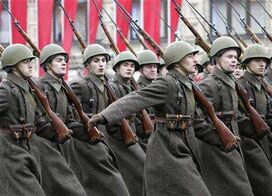
The Darnussian Army in 3035
The Darnussian Army, on the other hand, was a poorly trained, out-of-date and very underfunded organisation. Despite being massive in size in comparison to Keymon, there was no doubt Darnussia would suffer high casualties if they were to engage Keymon openly. The Darnussian Air Force at the time was called by conservative observers "the laughing stock of Terra", having extremely low-tech and out-of-date aircraft, along with appallingly trained pilots, and almost non-existent morale. The Darnussian Navy faired slightly better than the other branches in terms of shipping quality, yet the skill and training was still shockingly poor. What's more, Darnussia was still recovering from the uprisings of 3033, and the Second Democratic Republic was still very young. Internal division was extreme in the country, with two major power blocs having developed: the ultra-conservative and the far-left. Paramilitary activity was a constant problem, and Darnussia had almost no protection from invasion, air assault or nuclear attack.
It was clear this would not be a simple case of Goliath killing David. What's more, Keymon had Fascist Hutori standing by, an immensely powerful force, with a strong and well-trained armed force numbering 7 million. If they were to join the war, it would spell disaster for Darnussia.
Hutori declared war on Darnussia on the 12 October 3035, and pledged 1 million soldiers to Keymon immediately. Within 2 days, Darnussia was already in serious trouble.
Merenburg Bomb[]

Merenbürg after the attack.
The first strike of the war was the most devastating one. On 14 October 3035, at 2:50 am, a Keymonite small-class atomic warhead hit the historic capital of Darnussia, Merenbürg. It had been launched from a submarine in the Migrant's Pass, and hit the 'Old Town' district of the city in the early hours of the morning, exploding above the Johannson Bridge. 100,000 died immediately, followed by a further 55,000 in the subsequent fire storm and nuclear fallout. The centre of the city was completely gutted, with 4000-year-old architecture, art and culture wiped out. The city, that was sometimes called the "most beautiful city on Terra", had been destroyed in a split second, along with 155,000 people.
The result was extreme international condemnation of Keymon, and a mass turning of international opinion against them. The United Nations called it a crime against humanity, while 27 countries issued ultimatums condemning Keymon, and expressing support for Darnussia. A further 7 countries pledged humanitarian aid to Darnussia while Rutania began shipping state-of-the-art arms in their thousands to Darnussia. That single act of Keymons that was meant to cripple Darnussia, in fact strengthened it. The neutral world was now backing Darnussia.
Hutori blockade[]

Hutorian battleships set sail for Darnussia
The Hurotian Navy immediately sprung into action. The high-class battleships of the Fascist nations navel forces set sail for Darnussia in an effort to blockade Darnussia via the sea. This stopped large quantities of aid getting into Darnussia, however Luthori and Malivia still allowed planes to enter Darnussia over their airspace, much to the annoyance of Keymon.
Hutorian battleships very quickly engaged the Darnussian navy in the Migrant's Pass, and drove off the Darnussians by using better technology and tactics. Darnussias older, slower ships were no match for the Hutorian Navy. This blockade around Darnussia quickly became vital in protecting Keymon from Darnussian air attack. Darnussian planes were cut down in the sky by high-class Hutorian defence systems, and were useless in an attack against Keymon.
However, the blockade did little effect to the flow of supplies to Darnussia. Agricultural and industrial ties with the Holy Luthori Empire meant Darnussia did not suffer a food shortage, and medical supplies where imported through Malivia, much to the fury of Keymon. Darnussia did suffer however, in the imports of weapons and military supplies, as seaborne imports were cut off.
Lusitânian insurgency and beyond (July - September 3036)[]
Air raids[]
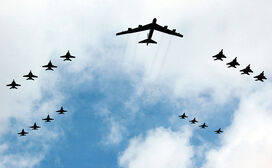
Hutorian Air Force flying over the Migrant Islands
The Keymonite and Hutorian Air Forces began numerous heavy raids on Darnussia to try and cripple the country and lower morale. Doressa and Moete were hit particularly hard in the ensuing attacks, and 20,000 Darnussian were killed overall throughout the rest of the war in the air raids. Darnussian anti-aircraft provisions did little to prevent the attacks, and Keymonite and Hutorian aircraft losses were low. While Hutori attempted to actually hit industrial and military areas and hurt Darnussian production and their economy, Keymon directly attacked civilian targets, such as schools, hospitals and churches. Moete Catholic Cathedral was flattened in an air-raid by Keymonite planes, and a major Doressa hospital was destroyed in a Keymonite raid.
The most controversial aspect of the raid was Keymons bombing of Darnussian refugee camps that housed those who had been evacuated from the cities. In September 3036, the attacking of Darnussian refugee camps in Malivia resulted in Malivia joining the war on Darnussia's side. These direct and deliberate attacks on the civilian population further alienated Keymon and resulted in aid and support to Darnussia increasing significantly.
However, by June 3036, the Darnussian military had reached full strength through conscription, with a total of 9 million men. This easily outnumbered both Hutori and Keymons military's, but Darnussias armed forces themselves were still poorly trained, poorly equipped and completely inexperienced. Darnussia's ships and planes continued to be cut down by the Hutorian Navy in the Migrant's Pass, and Darnussia was being bombed on a daily basis.
Lusitânian insurgency[]
Despite the war between the nations themselves, the conflict was originally based around one thing: Lusitânian terrorists. Recent evidence has shown that the threat to Darnussia from these Lusitânians was far less than stated at the time, but there was no doubt they were there and being funded by the Keymonite government. The fact that Lusitânia had not been a big issue in Darnussia for 700 years, there was no doubt there was still a small minority of Lusitânians who wanted to return to glory.

Lusitânian guerillas in Shirmania
Keymon saw the war as a perfect opportunity to fund a full-scall Lusitânian insurgency in Darnussia. Arms, aid and equipment were shipped out to the rebels. The landing of the arms on the southern Shirmania coast on 13 July 3036 was dangerous, and occurred at night, but even so still had to be cut short half way through when a Darnussian patrol spotted it and attacked. The Lusitânian guerillas where now heavily armed, however there were very few of them. Lusitânians make up only around 4% of Darnussias population, and the militant faction of them is almost insignificant. Overall, the United Front for the Liberation of Lusitânia, however, despite their heavy and advanced weaponry, only consisted of between 5-7,000 men.
Despite their small numbers, it was seized upon as a great propaganda opportunity by Keymon, who boasted they were the ones who "funded the Darnussian popular revolution" and how "even their own people are fighting the government". All this resulted in terror spreading through Shirmania, particularly Clenon, as there was fear of a Lusitânian take-over of government, or a genocide at the hands of the Lusitânians. This also resulted in a raising of morale in Keymon, where the actions of the Lusitânians were highly exaggerated and lied about. In actual truth, the insurgency caused little damage, but it still managed to wreak havoc on a Darnussian Naval base on the night on 10 August 3036, and strike fear into the hearts of the Darnussian populace.
The home fronts[]
Darnussia[]
Keymon[]
The tide turns (October 3036 - November 3037)[]
Malavian intervention[]
Despite the nuclear bombing of Merenbürg, and the deliberate attacks on civilians, by December 3036, Darnussia still stood alone in the war against Keymon. They were cut off by the Hutorian Navy, and therefore unable to counter-attack. Up until this point, Darnussia has been receiving large amounts of aid from Juclandia, but this was about it. Without a doubt, the cards were stacked up against Darnussia, and unless there was an intervention on Darnussia's side, the war would be over very soon, and not in Darnussia's favour.
Darnussia's saving grace actually came about due to the actions of Keymon. Between the 12-15 September 3036, Keymonite planes strafed and bombed Darnussian refugee camps in Malivia. Malivian towns were also hit in the attacks, and 350 civilians were killed. Outraged, Malivia immediately mobilised, and declared war on Keymon and Hutori, on 16 September. Malivia's mobilisation resulted in 6 million men joining the war on Darnussia's side, along with a modern and well-trained air force and a strong navy. Keymon and Hutori had now met their match, and very quickly, the pressure lifted off Darnussia. Now Darnussia and Malivia met to discuss the counter-offensive against Keymon, and the push that would eventually turn the tide in their favour.
Luthori intervention[]

Gordan Heinovich (left) meets with Reinhard I (left)
Darnussia then turned to the Holy Luthori Empire, their neighbours in the north, for support. Gordan Heinovich, the President of Darnussia, met with Luthori Emperor Reinhard I in Fort William in October 3036 to discuss Luthori joining the war. However, all that was agreed by the 15th, was a friendship treaty between the two nations. After four more days of discussion an agreement was met, and on the 20 October 3036, the Holy Luthori Empire declared war on Hutori and Keymon. Luthori's full-strength Army was mobilised, and the Navy, who were currently based down in Squibble, began to set sail back to Artania.
This intervention meant Darnussia had one of the strongest colonial powers on their side, with an immensely powerful navy and air force. Hutori straight away began to cancel its invasion plans of Darnussia, and prepared to go on the defensive. Luthori's intervention resulted in Keymon looking to Greater Hulstria for assistance, in the hope of starting a global war between the big three powers: Luthori, Hulstria and Zardugal. Hulstria however, despite numerous official visits from Keymon, and offers of lucrative war profits, was not interested, and refused to have anything to do with the conflict. It was clear, that the cards were stacking up against Hutori and Keymon.
Battle of Jan[]
- Main article: Battle of Jan

The Hutorian HMS Indefatigable opens fire during the Battle of Jan
The only major engagement of the war took place in the Migrant's Pass, 55 km off the coast of the small town of Jan in Clenon on the 1 November 3036. The Darnussian and Malivian navies took on the Hutorian Navy and won, therefore breaking the blockade and allowing for attacks against Keymon and Hutori to take place via sea. The Darnussian fleet encountered the Hutori fleet in the early hours of the morning, and engaged. The Malivian fleet, who were close behind, also attacked. Hutori stood strong however, and hit the Darnussians and Malivians hard. After 12 hours of fighting, 6 Darnussian ships, 4 Malivian and 11 Hutorian ships had been sunk, with 4,000 Darnussian dead, 1,500 Malivian and 6,000 Hutori dead. 4 Darnussian ships, 3 Malivian ships and 7 Hutori ships had also been heavily damaged. Around 400 aircraft were also lost, with more than half from Hutori. The remnants of the Hutorian Navy eventually surrendered.
The result was a major victory for Darnussia and Malivia, and a devastating defeat for Hutori. Much of Hutori's navy had been destroyed, and the blockade was broken. Hutori morale collapsed, while Darnussian morale soared. The Battle of Jan truly proved that the tide had really turned, and Keymon was now staring at the face of defeat. With Hutori beaten, and Luthori also joining, unless Keymon could find a new major ally, the end was nearing.
Keymonite defeat (December 3036 - November 3037)[]
Hutorian ceasefire[]
With the destruction of the Hutorian Navy at the Battle of Jan in November 3036, Hutori faced a serious problem. Now not only were they fighting one of the most powerful military alliances in the world, but they have no seaborne defence forces. Hutori was looking right in the face of disaster. In January 3037, the Hutorian military council met to discuss the possibility of pulling out of the war, but it was decided to carry on and avoid breaking the treaty with Keymon. In May, Hutori began suffering air raids of its own, mainly by Luthorian bombers. Not only this, but Hutori's ruling National Socialist Party began to come under attacks at home, as an increasingly powerful anti-war and pro-democracy movement began to take hold. Hutori was now beginning to get desperate.
On 30 May 3037, Juclandia declared war on Hutori and Keymom. This was yet another disaster for the Stalinist-National Socialist alliance. By June, Adrianopolis was flooded with pro-democracy demonstrators. 750,000 marched through the city, demanding an end to the war and multi-party democratic elections, as well as the beginning of an anti-fascist insurgency. The Hutorian army and government seemed powerless, and to make matters worse, unites of the Hutorian army began deserting and mutinying in droves. on 29 July 3037, the Hutorian military council met again, and this time agreed on a cease-fire for the 1 July.
Allied invasion of Maddog[]
- Main article: Battle of Maddog

Invasion of Maddog
With Hutori's defeat, the invasion plan of Maddog was made much simpler. Rather than having to fight a nation with an army of 6 million, Keymons tiny 70,000-strong armed forces seemed no match for the massively powerful 4-nation alliance. It was decided that 35,000 troops would be used in the mass seaborne landings on the western side of Maddog, and immediately be backed up by a further 40,000. Darnussian, Malivian, Luthori and Rutanian troops would be used in the attacks, along with Darnussia's elite Republican Guard. However, despite the superiority in fire-power and numbers, Keymons forces were well dug in throughout the island, and had massively powerful weapons technology and defence systems. And for such a small island, 70,000 was a massive amount of soldiers to be in one place. The result would, it was predicted, be anything but a walkover.
The invasion went ahead on 1 November 3037, and H-Hour was scheduled for 7:30 AM. The previous night, the Darnussian, Malivian, Rutanian and Luthorian navies had rendezvoused 45km west of Maddog. At H-Hour, 35,000 troops landed on the beaches of Maddog and very quickly overwhelmed the under-manned defences. The entire west-coast of Maddog was captured within 4 hours by the Allies, but to some heavy resistance. The Darnussian 4th Army suffered particularly heavy casualties, having around 1,500 killed by noon. It was by noon, however, that reinforcements began to arrive to back up the Allied forces. A beachhead was established to ensure the Allies could not be driven off the island. At the same time, Luthorian and Malivian aircraft began bombarding Keymonite positions inland, resulting in units of the Keymonite 1st Army. At this moment, Versteeg IV boarded a plane and fled to Hutori, and the same time demanding a fight to the death by his forces. However, his generals were already beginning to surrender to the Allied forces.
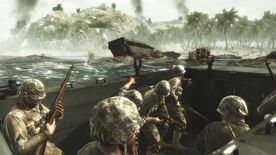
Malivian forces land on Maddog.
By 3:00 PM, a strong beachhead was in place, and the order was made by General Ludwig Hermann Tobias, commander of the attack, to advance. The Luthorians advanced on towards Laddon with minimal resistance and only around 100 casualties, and captured the town before 7:00 PM, and its defending garrison, who surrendered without a fight. The Rutanians advanced straight on to the town of Penrod, bypassing the positions of the Keymonite 1st Army in the centre of the Northern peninsula of Maddog. Penrod was taken with again minimal fighting, and around 250 Rutanian casualties. The Malivian 3rd and 5th Armies in the South however, had a different experience. The 3rd Army encircled Hen Swung, but this time the garrison fought back, inflicting heavy casualties on the Malivians with artillery, and prevented any advance towards the town using armour and machine guns. The 5th Army advanced straight into the heartland of Southern Maddog, and encountered the outskirts of Versteeg's elite troops, The Versteeg Column. Fighting was brief but fierce, again resulting in heavy Malivian casualties. By dusk, the Malivians had failed to make any significant advances into Maddog, or managed to capture any key objectives.
The Darnussian landing forces consisted of the Darnussian 1st and 4th Armies, and the Republican Guard. They suffered heavy casualties on the beach, and came under substantial Keymonite air attacks once inland. By noon, 1,500 Darnussian dead had already been reported. The 1st Army landed, before immediately heading north to attack the Keymonite 1st Army head on. Fierce fighting broke out, as a pitched battle was fought between the two armies, in a move that was later heavily criticised for causing needless casualties. At this battle, around 6,000 were killed, and lasted around 12 hours as the two sides tried to wear each other down. Darnussian casualties were much higher than the Keymonites, due to their dug-in defensive positions, and their better weaponry. However, the Darnussians eventually overwhelmed the Keymonites and forced a route, claiming victory and control over the northern side of the island. In the south, the 4th Army advanced around the Versteeg Column and straight on to Keymon City, before encircling it by around 5:00 PM. Darnussia's Republican Guard advanced and captured the base of the Versteeg Column after heavy fighting, and crushed the Keymonites in the south by nightfall, albeit with around 1,000 dead.
Defeat of Keymon[]

Keymonite soldiers surrender to Malivian troops, 3 November 3037.
At 8:30 AM on 2 November 3037, armoured units of the Darnussian 4th Army entered Keymon City, and were met with heavy resistance. They were soon backed up by around 4 waves of infantry, who reached the city centre by 11:45 AM through heavy fighting. The Malivian 9th then began advancing into the city in a mop-up operation. The Presidential Palace was captured at 4:00 PM, and the Keymonite House of Representatives fell to Darnussian foces at around 8:00 PM. It was at 9:30 PM, with fighting still going on in the city, that seventeen out of the twenty five members of the Keymonite High Command were discovered in a bunker in the city centre. All were arrested and taken off for questioning. On 3rd November, a further three were discovered on Maddog. It was revealed that the remaining five at fled the country along with Versteeg.
The Keymonite City Garrison surrendered at noon on 3 November, meaning the city had fallen to the Allies. Hen Swung was also finally captured by the Malivians by dusk on 3 November. However, the Keymonite Air Force continued to hit Allied positions from airbases still under Keymonite control in the north. By 5 November, the last of these had fallen to Rutanian troops. It was by November 6 that all Keymonite troops had surrendered or been killed, meaning resistance was over. At noon on November 6, the Keymonite High Command signed a ceasefire on all fronts, meaning Darnussian victory in the war. However, it was not until 10 November that Keymon formally surrendered. Frederick Paas, new acting Head of State in Versteeg's absence formally surrendered unconditionally the Democratic People's Republic of Keymon to the Second Darnussian Democratic Republic, the Republic of Malivia, the Socialist Republic of Juclandia and the Holy Luthori Empire at 4:00 PM on 10 November 3037. The war was over.
Aftermath[]
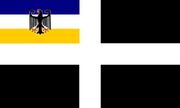
Darnussian Commissariat of Keymon
Approximately 212,000 people were killed in the war, including 178,000 civilians and 34,000 military dead. The cost of the war was astronomical, especially for Darnussia, who found themselves in deep debt after, especially to Luthori. Politically, Hutori and Keymon were completely transformed. Hutoris 150 year-old ruling National Socialist Party was overthrown in a popular revolution in the December of 3037, and multi-party democracy was introduced. Keymon, however, was occupied for 12 years by Darnussia, before being granted independence in 3049 as a multi-party democratic republic.
The largest legacy of the war was the bombing of Merenbürg, in which 155,000 people were killed. Merenbürg lay empty and deserted for 10 years, before being resettled in 3045. It was fully rebuilt and was back to its pre-war population by 3090. However, the city's 3,000-year-old architecture, art and culture was wiped out, and the legacy of ancient Narikaton, one of the oldest and most influential civilisations in Terra, was destroyed. The effects of radiation are still being felt by the modern day population, and as a result, the true death toll may never be known.

Darnussian Military Cemetery in Red Stad, containing 5,000 bodies.
Further effects included the Famine Scare in Darnussia in 3070, when Darnussia, forced to continue repaying its war debt to Luthori by purchasing price-inflated food from them almost went into a serious famine after imports of food plummeted after a harsh winter. Only intervention by Zardugal prevented mass starvation in Darnussia. Keymon was plagued by internal strife and civil war between the years 3055-3080, as anarchists, democrats and monarchists wrestled for control of the country. In 3091, the Glorious People's Empire of Keymon was founded, with Versteeg IV's son, Versteeg V, in the war fighting on the side of the Darnussians, as the emperor, much to the alarm of Darnussia. Hutori's democracy was crushed as the National Party seized control in a coup, and an international crisis began as Hutori began slaughtering its own citizens.
Alleged war crimes[]
- The bombing of Merenbürg - The United Nations called the atomic bombing of Merenbürg at the time a "war crime", as it violated UN rules about attacks on civilians. Other observers said the massively high death toll, followed by the ruthless attack on innocent and defenceless civilians makes it without a doubt a crime of war.
- Execution of Darnussian POWs - Versteeg IV ordered the massacre of captured Darnussian airmen and seamen in March 3037. Around 2,000 were slaughtered at the hands of the Versteeg IV loyal.
- Bombinf of Darnussian refugee camps - Another crime attributed to the personal orders of Versteeg IV, who ordered that the Keymonite air force should attack refugee camps in Malivia set up for displaced Darnussian civilians. These attacks resulted in 500 deaths, and succeeded in drawing Malivia into the war.
